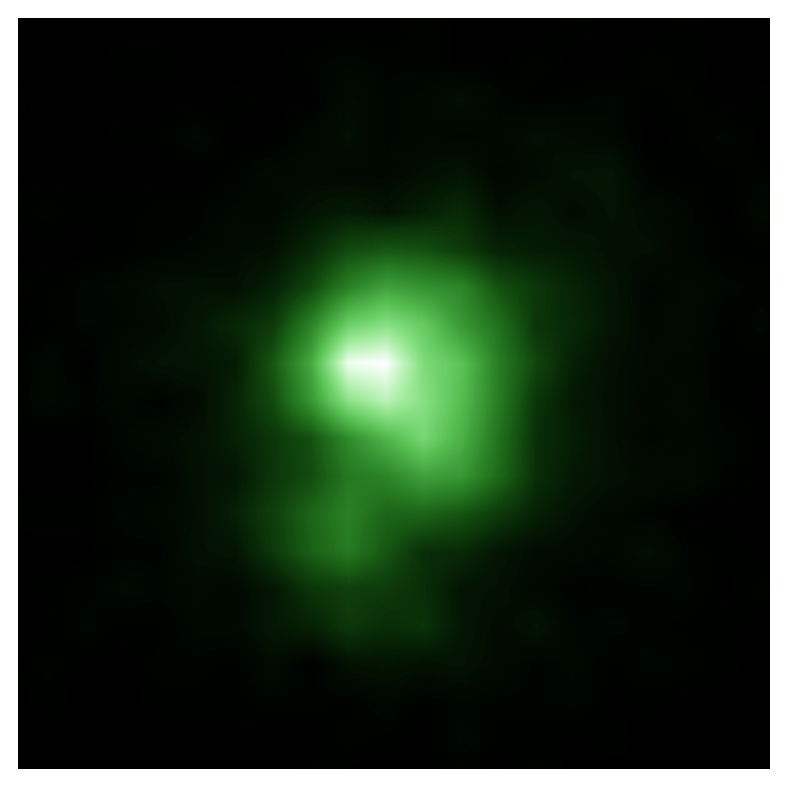

The "green pea" galaxy J0925+1403 as imaged with the Hubble Space Telescope. This is a smoothed-out false color image in the near-UV (HST/COS around 230 nm), colored green to evoke the green color the galaxy would have if imaged in visible light.
At about 6000 light-years, the diameter of the galaxy is less than 1/15 the diameter of the (visible parts of) the Milky Way Galaxy. Astronomers found that 8% of the intense UV radiation produced in this galaxy escaped into the surrounding space - enough for galaxies of this type to have caused the reionization of the universe shortly after the Big Bang.
Image: Ivana Orlitová, Astronomical Institute, Czech Academy of Sciences (Prague)
After the Big Bang 13.8 billion years ago, the universe cooled down rapidly, and within less than a million years the cosmos became completely dark. The transition from this dark age to the epoch of the first stars and galaxies is one of the least-understood periods in cosmic history.
Now, astronomers including Gabor Worseck from the Max Planck Institute for Astronomy have confirmed that compact low-mass galaxies known as “green peas”, which form new stars at impressive rates, could have been key players in that transition.
Such green peas are interesting candidates as drivers of reionization, which set in roughly 150 million years after the Big Bang, when most of the hydrogen atoms in the early universe were separated into electrons and protons. Star-forming galaxies like this should produce a significant number of massive stars, which in turn produce ultraviolet radiation sufficiently energetic to ionize hydrogen.
But so far, nobody had been able to show that galaxies of this type emit sufficient amounts of high-energy radiation to drive reionization – on the contrary, all previous observations had shown galaxies where most of the ultraviolet radiation is absorbed within the galaxy itself, with the remainder insufficient to account for reionization.
Moreover, direct observations of the escaping ultraviolet radiation are possible only in the nearby Universe: For really distant galaxies, almost all such radiation will be absorbed by intergalactic hydrogen before reaching Earth.
That is why the researchers, led by Yuri Izotov of the National Academy of Sciences of Ukraine, set out to find intensely star-forming green pea galaxies in the nearby universe, using data from the Sloan Digital Sky Survey (SDSS) to select promising candidates. The five top candidates were then observed with the Hubble Space Telescope.
This is where Gabor Worseck came in, a post-doctoral researcher at MPIA. As Worseck explains: “These observations were an ideal fit for a method of analyzing Hubble spectral data that I had developed over the last years. In this way, we were able to measure precisely the amount of ultraviolet radiation emitted by the five green pea galaxies.”
One candidate galaxy in particular, with the designation J0925+1403, proved particularly efficient: a sizeable 8% of its ultraviolet radiation leak out into the surrounding space, where it should be able to ionize intergalactic hydrogen gas more than 40 times as massive than the galaxy itself.
The discovery shows that green pea galaxies should indeed be sufficiently powerful to have brought about reionization. Ancient specimens of this type of galaxy could well be responsible for lifting the universe out of its dark age directly after the Big Bang.
Background information
The work described here is published as Y. I. Izotov et al., “Lyman continuum leaking from the compact star-forming dwarf galaxy J0925+1403” in the January 14, 2016 edition of the journal Nature. Media representatives should contact r.walton@nature.com for access to the article.












